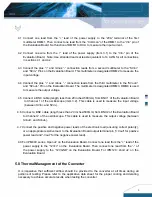
6.0 Tests Performed
performed at room temperature (+25 C).
6.1
Input Voltage Range.
ut.
.
6.2 O
Line Regulation.
.
t-Point Adjustment Range.
6.3 D
Maximum Output Voltage Deviation (due to step change in load).
6.4
Efficiency
e
part number of the power module to determine that the correct module is
being evaluated. Note: IPM12C0A0
S
04A and IPM04C0A0
S
06A would denote the SMT
2)
t multimeters DMM2 and DMM3
to DC voltage, auto ranging.
3)
Turn on the Electronic Load (or resistive load) and adjust the current level. The maximum
nt is 4A for the model IPM12C0A0R04A series and 6A for the model
4)
ble or disable the converter. Turn SW1 to the OFF position to enable
e converter, and turn SW1 to the ON position to disable the converter.
5)
position if this
nction is not being used. Turn SW2 to the ON position if the Transient function test is
The following tests are
Input Characteristics
Under-Voltage Locko
No Load Input Current
utput Characteristics
Load Regulation.
Output Regulation
Output Voltage Se
ynamic Characteristics
Turn on Response time.
Thermal Characteristic
7.0 T
st Set-Up
7.1 Initial Set-Up
1) Examine the
package, while IPM12C0A0
R
04A and IPM04C0A0
R
06A would denote the SIP package.
This Evaluation Board can be used for both packages.
Set multimeter DMM1 to the DC current 20A range. Se
Electronic Load
rated output curre
IPM04C0A0R06A series. Ensure the output load does not exceed the recommended
maximum current.
SW1 is used to ena
th
SW2 is used for On/Off Transient function test. Turn SW2 to the OFF
fu
required.
4
Содержание DEP-003
Страница 14: ...14 Appendix A Evaluation Board Schematic ...
Страница 15: ...15 Appendix B Evaluation Board Layout Top View ...


































